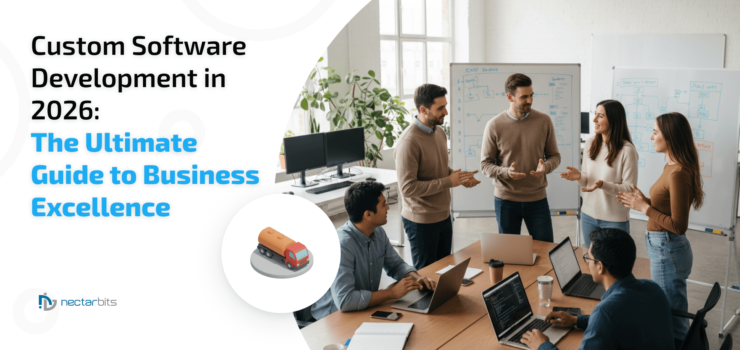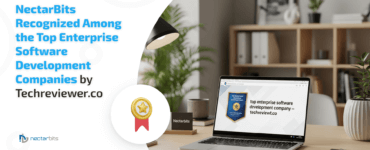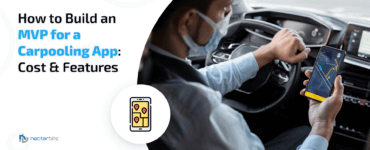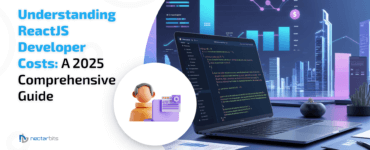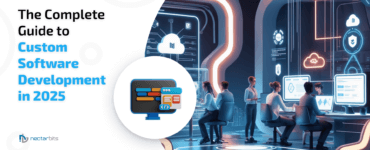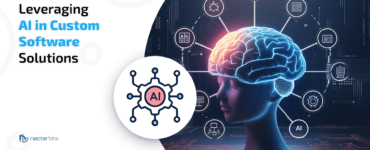In the hyper-competitive landscape of 2026, businesses can no longer rely on one-size-fits-all solutions to get ahead. Off-the-shelf software, with its generic features and rigid limitations, often forces companies to adapt their processes to the technology. True market leaders do the opposite: they adapt technology to their processes. This is the power of custom software development, creating tailored, high-performance digital solutions that are perfectly aligned with your core business strategy to drive unparalleled efficiency, innovation, and growth.
This comprehensive guide explores the world of custom software, from initial strategy to advanced implementation. We will cover why it’s a critical investment, how the development process works, and the key trends shaping the future of business technology.
The Strategic Imperative: Why Choose Custom Software?
While the initial investment for custom software can be higher than buying a pre-packaged product, the long-term return on investment is significantly greater. A custom solution is not an expense; it’s an asset built to give you a competitive edge.
Key Advantages Over Off-the-Shelf Software:
- Perfect Functional Alignment: Custom software is built to your exact specifications. You get all the features you need and none that you don’t, resulting in streamlined workflows and higher user adoption rates.
- Infinite Scalability: As your business grows, your software grows with you. Custom solutions are designed with scalability in mind, able to handle increased user loads, data volumes, and functional complexity without a complete overhaul.
- Seamless Integration: Custom applications are engineered to integrate flawlessly with your existing systems, be it your CRM, ERP, or other legacy software. This creates a unified tech ecosystem, eliminates data silos, and automates information flow across your organization.
- Enhanced Security and Compliance: Generic software can present security vulnerabilities. Custom solutions allow you to build robust, industry-specific security protocols and compliance features (like HIPAA or GDPR) directly into the architecture, offering superior protection for your sensitive data.
- Unique Competitive Advantage: A custom solution can embody your unique business processes and proprietary workflows, creating a competitive moat that others cannot easily replicate with off-the-shelf products.
The Blueprint for Success: Mastering the Software Development Lifecycle (SDLC)
Creating a powerful custom application follows a structured, multi-stage process known as the software development lifecycle (SDLC). This proven framework ensures a high-quality outcome that meets business objectives on time and within budget.
- Requirement Gathering and Discovery: This is the most crucial phase. It involves in-depth workshops and analysis to understand your business challenges, goals, and user needs. A thorough requirement gathering process ensures the entire project is aligned with your core business strategy from day one.
- Architectural Design and Planning (UI/UX): Once the requirements are clear, architects and designers create a blueprint for the software. This includes defining the technology stack, system architecture, database design, and creating an intuitive User Interface (UI) and engaging User Experience (UX).
- Agile Development and Coding: The designs are transformed into functional code. Modern teams use Agile methodologies, breaking the project into short cycles called “sprints.” This allows for iterative progress, regular feedback, and the flexibility to adapt to changes, ensuring the final product truly meets your needs.
- Continuous Testing and Quality Assurance (QA): Quality is built-in, not bolted on. Throughout the SDLC, rigorous testing, including unit, integration, performance, and security testing, is conducted to identify and eliminate bugs, ensuring the final product is reliable, stable, and secure.
- Deployment and Implementation: The completed and tested software is deployed into a live environment. This phase includes careful planning for data migration and user training to ensure a smooth transition and successful adoption.
- Ongoing Maintenance and Evolution: The journey doesn’t end at launch. Continuous maintenance, performance monitoring, and planned updates are essential to keep the software running smoothly, secure it against new threats, and add new features as your business evolves.

Key Technology Trends Shaping Custom Software in 2026
To stay competitive, your custom software should leverage cutting-edge technologies that unlock new capabilities and efficiencies.
Leveraging AI and Machine Learning (ML): The Intelligent Core of Modern Software
In 2026, Artificial Intelligence (AI) and Machine Learning (ML) are no longer just features to be added to software; they are the foundational core upon which intelligent, adaptive, and autonomous applications are built. Custom software development provides the perfect vehicle to harness the full power of AI, creating solutions that don’t just execute commands but also learn, reason, predict, and create.
By building custom AI-powered solutions, businesses can move beyond simple automation and create systems that deliver unprecedented levels of insight and operational efficiency.
From Automation to Autonomy: Redefining Business Processes
The first wave of automation was about making repetitive tasks faster. The AI-driven wave is about automating complex decision-making itself, creating systems that can operate with a high degree of autonomy.
- Intelligent Process Automation (IPA): This goes far beyond simple scripts. Custom AI models can analyze incoming documents (like invoices or contracts), extract relevant information, validate it against business rules, and route it for approval, all without human intervention. This is powered by a combination of Natural Language Processing (NLP) for understanding text and computer vision for reading documents.
- Prescriptive Analytics and Decision Support: While predictive analytics forecasts what might happen, prescriptive analytics recommends the best course of action. A custom logistics application, for example, won’t just predict a potential supply chain delay; it will automatically analyze all possible alternative routes, calculate the cost and time implications of each, and recommend the optimal solution to the human operator.
- Next-Generation Conversational AI: Forget clunky, rule-based chatbots. Modern custom solutions leverage advanced Generative AI and Large Language Models (LLMs) to create sophisticated virtual assistants. These AI agents can understand nuanced customer queries, access knowledge bases to provide detailed answers, perform tasks on behalf of the user (like booking an appointment or processing a return), and even detect user sentiment to escalate a conversation to a human agent when necessary.
From Hindsight to Foresight: The Power of Predictive
Intelligence
Custom AI/ML models can analyze your historical and real-time data to uncover hidden patterns and forecast future outcomes with remarkable accuracy, allowing you to shift from a reactive to a proactive business posture.
- Advanced Demand Forecasting: In e-commerce and retail, AI can analyze not just past sales data but also external factors like weather patterns, social media trends, and competitor promotions to predict demand for specific products with far greater accuracy than traditional methods. This allows for optimized inventory management, reducing both stockouts and costly overstock.
- Predictive Maintenance and Asset Management: As covered in IoT, AI models can predict equipment failure before it happens, but the application is broader. AI can also predict resource needs, IT system loads, and even potential project delays, allowing managers to allocate resources proactively.
Risk and Fraud Detection: In the financial sector, custom ML models are indispensable. They can analyze thousands of transactions per second to identify anomalous patterns indicative of fraud, flagging them in real-time. Similarly, AI can assess credit risk with greater accuracy by analyzing a much wider range of data points than traditional credit scoring models.
The Age of Hyper-Personalization and Generative Experiences
Generic user experiences are a thing of the past. AI allows you to treat every user as an individual, tailoring their journey in real-time to maximize engagement and conversion.
- Dynamic Personalization Engines: A custom e-commerce platform can use AI to do more than just recommend products. It can dynamically change the entire layout of the website, highlight different value propositions, and even adjust pricing or promotions in real-time based on a user’s browsing history, past purchases, and demographic profile.
- Generative AI for Content and Communication: This is a game-changer. Custom software can now integrate Generative AI to create unique content on the fly. This includes:
- Personalized Marketing Copy: Automatically generating email subject lines, product descriptions, and ad copy tailored to specific customer segments.
- Automated Reporting: Transforming complex data dashboards into easy-to-understand narrative summaries for business executives.
- Creative Assistance: In design or media applications, AI can suggest layout options, generate background images, or even compose music, acting as a co-pilot for human creativity.
By building custom AI solutions, you are not just acquiring a tool; you are embedding an intelligent, learning brain into the very heart of your business operations. This allows you to create systems that are more efficient, forward-looking, and deeply personalized, providing a powerful and sustainable competitive advantage.
Integrating IoT, Big Data, and AI: Creating an Intelligent Digital Ecosystem
The integration of the Internet of Things (IoT) and Big Data is no longer just about connecting devices and collecting information; it’s about creating a sentient, intelligent digital nervous system for your entire operation. When you infuse this combination with the power of Artificial Intelligence (AI) and Machine Learning (ML), you create a powerful trifecta that transforms raw data into autonomous actions and predictive insights.
Custom software is the essential glue that binds these technologies together, creating a seamless flow from data acquisition to intelligent decision-making.
The Synergistic Loop: How It All Works
Imagine a continuous, self-optimizing loop where your business gets smarter with every piece of data it collects. This is the reality of a well-architected IoT, Big Data, and AI solution.
- Sense (The IoT Layer): This is where data is born. Millions of sensors embedded in everything from factory machinery and delivery vehicles to smart thermostats and retail shelf scanners are constantly generating real-time information about the physical world. This includes data on temperature, location, vibration, motion, moisture, light, and much more.
- Collect and Process (The Big Data Layer): This massive, high-velocity stream of data, often unstructured, is far too large for traditional databases to handle. Custom Big Data solutions built on cloud platforms are designed to ingest, process, and store this information securely and efficiently, preparing it for analysis.
- Analyze and Predict (The AI & ML Brain): This is where the magic happens. Custom software equipped with AI and ML algorithms acts as the central brain, sifting through the torrent of data to identify patterns, detect anomalies, and make predictions that are impossible for humans to see. Key AI trends driving this capability include:
- Predictive and Prescriptive Analytics: AI doesn’t just predict when a machine might fail (predictive); it can also recommend the specific actions to prevent it (prescriptive). It analyzes vibration, temperature, and performance data to forecast failures with incredible accuracy.
- Computer Vision: IoT cameras and sensors provide visual data. AI-powered computer vision can automatically monitor assembly lines for quality control, detect safety hazards in a warehouse (e.g., a worker not wearing a hard hat), or analyze customer foot traffic patterns in a retail store.
- Anomaly Detection: ML models learn the “normal” operating behavior of a system. They can instantly flag any deviation, like a sudden drop in pressure in a pipeline or unusual network traffic, preventing costly failures or security breaches before they escalate.
- Natural Language Processing (NLP): AI can analyze unstructured text data from technician logs or customer feedback and correlate it with IoT sensor data. For example, it might find a link between certain error codes reported by technicians and specific vibration patterns from a machine, leading to faster root cause analysis.
- Act (Intelligent Automation): The final step is to close the loop. Based on the AI’s analysis, the custom software can trigger automated actions without human intervention. This is where true operational efficiency is unlocked.
Transformative Business Applications Fueled by This Integration
When this loop is in place, it enables revolutionary business capabilities:
- The Rise of Digital Twins: Create a perfect, real-time virtual replica of a physical asset, process, or entire factory. By feeding live IoT data into this digital twin, you can run simulations, test “what-if” scenarios, and optimize performance without any real-world risk. For example, you could test how a change in a machine’s settings will affect production output before ever touching the physical equipment.
- Hyper-Automated Supply Chains: Go beyond simple tracking. An intelligent supply chain can use IoT data to automatically reroute shipments around bad weather, predict demand spikes based on real-world events, and even trigger automated orders when inventory levels in a smart warehouse fall below a certain threshold.
- Personalized Customer Environments: In retail, IoT sensors can track how customers move through a store, while AI analyzes this data to optimize store layouts and personalize digital signage in real-time. In hospitality, smart rooms can learn a guest’s preferences for lighting and temperature and adjust them automatically.
- Proactive and Resilient Infrastructure: For cities and utilities, IoT sensors on bridges, pipelines, and the power grid can provide early warnings of structural stress or potential outages. AI can analyze this data to prioritize repairs and allocate resources effectively, creating safer and more resilient public infrastructure.
By integrating IoT, Big Data, and trending AI capabilities, custom software development moves beyond simple applications and becomes the architect of intelligent, self-optimizing systems that deliver an unparalleled competitive advantage.
Building on the Cloud
Cloud platforms like AWS, Azure, and Google Cloud offer unparalleled flexibility, scalability, and cost-efficiency. Cloud-native development allows your custom software to be resilient, easily scalable, and accessible from anywhere, while reducing your overhead on physical server maintenance.
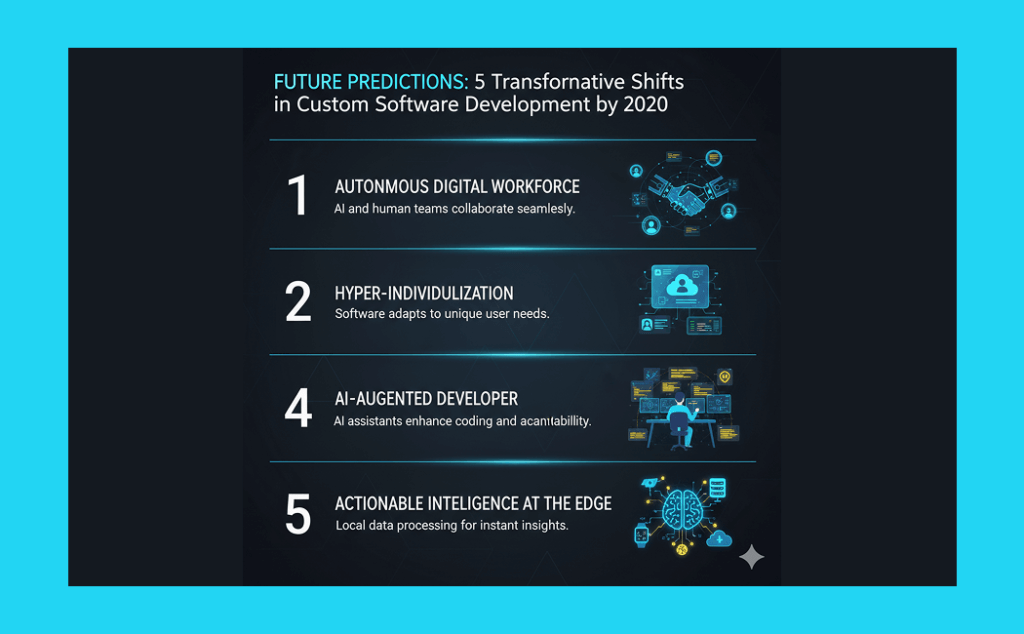
Future Predictions: 5 Transformative Shifts in Custom Software Development by 2030
The current trends in custom software are not the final destination; they are the launchpad for a future where technology becomes truly intelligent and autonomous. Based on the trajectory of AI, data, and business needs, here are five key predictions for the evolution of custom software in the coming years.
1. The Rise of the Autonomous Digital Workforce
The future of automation is not just about tools that assist humans, but about autonomous AI agents that function as digital employees. Custom-built AI agents will be tasked with entire business functions, such as managing a supply chain, reconciling complex financial accounts, or even running marketing campaigns. These agents will operate proactively, predicting issues, modeling solutions, and executing complex, multi-step tasks across various systems without human intervention. The focus of custom development will shift from building applications for people to building autonomous workers alongside them.
2. Hyper-Personalization Will Evolve into Hyper-Individualization
Personalization today means showing relevant product recommendations. The future is hyper-individualization, where the software experience itself is generated uniquely for each user in real-time. A custom application’s entire User Interface (UI), from the layout and features displayed to the data it presents, will dynamically morph based on the user’s role, skill level, and immediate goals. Powered by Generative AI, software will create an audience of one, ensuring every interaction is perfectly optimized for that specific user at that specific moment.
3. The “AI-Augmented” Developer Becomes the Standard
AI will not replace skilled software developers; it will fundamentally change their role. The tedious work of writing boilerplate code will be almost entirely offloaded to AI co-pilots. The value of a human developer will shift toward strategic architecture, creative problem-solving, and AI model training. The most sought-after skill will be the ability to design complex, interconnected systems and effectively guide, fine-tune, and validate the work of their AI partners. The role will be less “coder” and more “AI systems architect.”
4. Explainable AI (XAI) Will Move from a Feature to a Legal
Requirement
As AI agents make increasingly critical decisions in finance, healthcare, and human resources, the “black box” approach will become untenable. Regulatory bodies and the public will demand transparency. Explainable AI (XAI), the ability to audit and understand why an AI made a specific decision, will become a legally mandated requirement for many industries. This will be a primary driver for custom software, as companies will need to build auditable, transparent AI systems to manage legal liability and build trust with customers.
5. “Big Data” Will Be Replaced by “Actionable Intelligence” at the Edge
The era of simply collecting and storing massive amounts of data (“Big Data”) is ending. The future is about processing data instantly, where it is created at the “edge” and turning it into immediate action. Custom software solutions will focus on “Decision Intelligence,” where streams of data from IoT devices are analyzed in real-time by AI models located on-site. The goal will no longer be to create a historical report for a human to analyze later, but for an autonomous system to make an intelligent decision and act on it in milliseconds.
Specialized Solutions: Mobile and Cross-Platform Development
In a mobile-first world, reaching your users on their preferred devices is non-negotiable. Mobile app development is a critical component of a comprehensive digital strategy.
- Responsive Web Development: The foundation of any modern online presence is a responsive website that provides a seamless experience across desktops, tablets, and smartphones.
- Native and Hybrid Mobile Apps:
- Native Apps (one for iOS, one for Android) offer the highest performance and best access to device features. They are ideal for demanding applications where user experience is paramount.
- Hybrid or Cross-Platform Apps (using frameworks like React Native or Flutter) enable you to build a single app that works on both platforms. This approach can significantly reduce mobile app development time and cost, making it an excellent choice for many businesses.
Conclusion: Begin Your Digital Transformation Journey
In 2026, custom software is the engine of business innovation. It’s about more than just code; it’s about creating a strategic asset that empowers your team, delights your customers, and drives sustainable growth. By moving beyond the limitations of generic software, you can build a technological foundation that is uniquely yours.
Your journey begins with a clear vision. A successful custom software development project starts with a thorough requirement gathering process that deeply understands your core business strategy. By investing the time to define your needs, you set the stage for a solution that will not only solve today’s challenges but also unlock tomorrow’s opportunities.

FAQs:
If your business relies on unique workflows, has complex integrations, or needs a scalable system that can evolve with you, custom software is the better choice. Off-the-shelf products are fine for basic needs, but they often limit innovation and can’t easily adapt to your long-term strategy.
Timelines vary depending on complexity and features. A small MVP (Minimum Viable Product) can take 3–6 months, while enterprise-grade systems may take 9–18 months. Agile development cycles allow faster iterations and early releases, so you can start using core features sooner while the rest of the system evolves.
Before approaching a developer, outline your business goals, pain points, and expected outcomes. Define must-have features, user types, and integration requirements. A clear problem statement helps developers recommend the right technology stack, architecture, and delivery model for your needs.
Ask your development partner to use a modular architecture, cloud-native infrastructure, and API-first design. Make sure they plan for scalability from day one — including load balancing, containerization (Docker/Kubernetes), and continuous maintenance. Regular updates and performance monitoring are also key to long-term adaptability.


